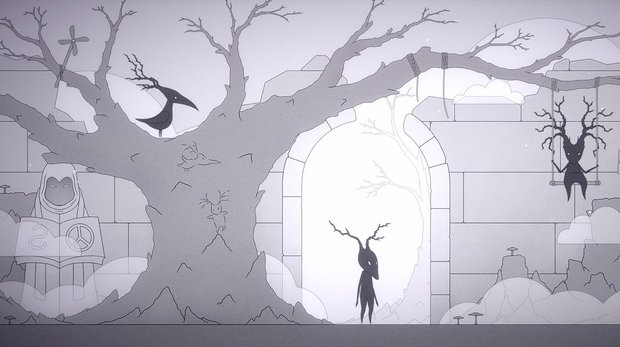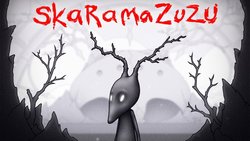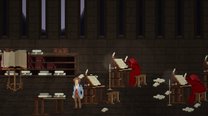Skaramazuzu review

- 0 Comments
The gorgeously macabre black-and-white visuals will draw you in, but the tedious fetch quests might scare you back out
Many of Skaramazuzu’s individual parts work quite well on their own. The eerie, melancholy world is so visually arresting—its atmosphere so gravid with both magic and menace, its stark black and whites so well-complemented by the mournful soundtrack and otherworldly audio design—that it almost surprised me to realize, midway through, how impatient I was for it to be over. Here was a strange and original setting populated by odd beasts and strangely lovable shadow creatures, whose every screen teased mysterious new possibilities … and the only thing anybody could think of for me to do there was to wander back and forth around a circular hub, picking up item A and carrying it several screens away to character B, all so I could be told, at length, where and how to do it again.
The problem lies in the gap between what Skaramazuzu does on its own—its aesthetics, its themes, its hints at a larger picture—and what it wants the player to do, which amounts to mindless busywork. In another, non-interactive medium—as a picture book, maybe, or an animated short—it might have been a success. You could skip over all the tedious wandering, simply cutting back and forth between the parts where things actually happen. Any work that casts its audience as active participants, though, has to make doubly sure it’s worth their time, energy, and attention; otherwise they’re liable to give up and go find something else to do. As it is, Skaramazuzu offers sumptuous visuals, an enticing setting, and approximately three hours of monotonous, over-explained drudgery.
The game begins as a sphere of light suddenly materializes in the darkness of the Void. Conscious, but lacking tangible form, memory, or sense of self, it wonders aloud about who and what it is. This nameless spirit soon encounters a cosmic being called the Master, who bestows upon it the name Skaramazuzu—Zuzu for short. The Master then dispatches Zuzu to another realm with the instruction to find and activate four hidden Orb Keys that will unlock the truth about their identity. (Characters are apparently genderless, referring to each other exclusively by their proper names and eschewing even neutral pronouns; a typical sentence might read something like “I spoke to the Master and the Master told me what the Master wanted me to do.” It’s an affectation that mostly works in the otherworld of the game, but to avoid awkward phrasing here I’ll default to they and them.)

Zuzu awakens in a monochrome world, with a physical body seemingly crafted from pure shadow. Wherever this place is, it appears constructed and self-contained; everywhere are stone edifices and high walls ensuring that one sticks to a circular path. Zuzu begins exploring, looking for others who might know more about this place. You control Zuzu along a linear two-dimensional plane, moving left or right (and occasionally up or down to exit certain screens). An exclamation point pops up to mark those areas of interest where a dedicated button will bring up the “talk to” and “interact” prompts. The latter of these opens your inventory, where you can scroll through to select what to use on the current hotspot. (Controls are optimized for a gamepad, but a keyboard/mouse combo is also supported.)
Zuzu has an amusingly animistic view of the world, frequently lapsing into one-sided conversations with inanimate objects, and you’ll get more mileage out of the “Talk to” function than a lot of games give you. Talking to an object you intend to take often leads Zuzu to ask if it would like being picked up, expressing delight at its inaudible (but apparently affirmative) response. No matter what you choose to talk to, you’ll usually hear a unique bit of dialogue; there are also scads of optional conversations to be had with side characters after significant plot developments.
The characters you meet are all cast from a similar visual mold, with spindly, horned silhouettes not unlike Zuzu’s own. Each is named for the role or archetype they embody within the setting—Gardener, Gravekeeper, Kid, Creature—with their characterization mostly stemming from the same place. While they appear as shadowy, antlered humanoids for the most part (give or take a few animals, spirits, and monsters), the template proves surprisingly versatile, with subtle differences communicating small details about each character’s personality. Zuzu’s slim frame and slightly bowed head, for instance, emphasizes their vulnerability and trusting, innocent nature, while Kid’s wildly branching antlers call to mind an adventurous child’s omnidirectional energy.

The setting has the appearance of an ornately crafted puppet theater. The scenery, with its bold lines and impressively fluid ambient animations, is laid out in a way that suggests a theatrical backdrop beneath a proscenium. The characters themselves have a paper-doll, shadow-puppet quality to them (albeit with much smoother movements) that foregrounds the constructed, intentional character of this world-between-worlds. Menace and melancholy are everywhere: the stone facades are crumbling; the trees are bare and skeletal; statues of hooded figures loom ominously in the background, their eyes shifting to follow Zuzu’s progress. There are moments of deeper darkness in which threatening beasts appear, with occasional sudden violence that’s no less shocking simply because it’s happening to ragdoll-esque homunculi.
The music is low and spooky, a rolling synth-hum that helps set the mood; often it seems to mimic a cold wind or bare branches clattering in the breeze. It’s subdued for the most part, rarely rising into the foreground except during moments of intense emotion. Frequently it vanishes entirely, leaving you alone with the ambient noises of rustling underbrush, crackling leaves, and Zuzu’s lonesome, echoing footsteps. There’s no voice acting per se, but each character’s dialogue is accompanied by babbling speech-sounds in line with their personality. Zuzu’s is high-pitched and fast-paced, reflecting their childlike enthusiasm; the Master’s is deep, slow, and sonorous; the fire spirit Pyro speaks with the pop and hiss of flame behind every line.
With such attention paid to establishing its setting and atmosphere, Skaramazuzu seems poised to let you dig deep and uncover its secrets … but the illusion of a deep and vibrant world to explore breaks up quickly. Aside from occasional instances where you’ll have to use an inventory item—mostly of the “use key on lock” variety—and a few combination locks with clues scattered throughout the environment, the lion’s share of puzzles are uncomplicated “Who has what?” fetch quests. A character has something you want; they tell you what item they’d trade it for; you wander around the circular hub until you find another character who either has what the first person wants or knows where to find it; you repeat the process for that person, and so on. It’s less a series of puzzles than it is a tangled ball of string with loose ends poking out here and there. You might not know what’s connected where, but with such limited options you don’t need to think too hard to sort them out.
The result is that you spend most of the game simply wandering back and forth around the same handful of screens, finding out what different characters need and asking others if they have it. More than once, on learning an additional item is necessary to get what a character’s asked you for, the solution to the “puzzle” turns out to be … to just go back and ask the quest-giver if they have it, at which point they either hand it to you outright or tell you who can.

Character interactions, while not exactly minimal, center almost entirely on setting up your next objective or recapping what you just did. You’ll learn enough about each person you meet to grasp the basics, but even with all the optional exchanges there’s little to make them feel like much more than information-dispensing hotspots. Some conversations are entertaining—especially between the childlike Zuzu and a married couple who employ increasingly desperate euphemisms to avoid explaining that what they need is an aphrodisiac—but for the most part they’re purely functional, and often aggressively so.
Consider the following exchange, as Zuzu tries to access a graveyard:
Gravekeeper: To enter you must first pay one Gold Coin.
Zuzu: One Gold Coin?
Gravekeeper: Yes, one Gold Coin. That is the rule.
Zuzu: But I don’t have one Gold Coin.
Gravekeeper: I’m sorry Zuzu, but you’ll have to pay one Gold Coin. One Gold Coin to enter the graveyard. That is the rule.
Zuzu: I see. Well…I’ll go and see if I can find one Gold Coin.
Did everybody get all that???
I’d estimate I spent around 15-20% of my time with Skaramazuzu listening to characters repeat what they or someone else had just said. The game really, really wants to make sure you haven’t missed anything; it’s already provided you with a diary function that automatically tracks your objectives, but it seems to lack confidence in your ability to use it. This despite the fact that there’s only a few hours of game to potentially get lost in, with puzzles rarely more complex than “Find the specific object someone told you to look for” or “open the door by inputting the obtrusively placed symbols you’ve seen nearby.”
The repetitive dialogue undermines the game’s attempts to tell a story full of big emotions and cathartic moments, with characters simply stating, again and again, exactly what they’re thinking and feeling. There’s no space for you, the player, to feel or think anything of your own in response. To inspire an emotional reaction, one must create a set of circumstances that provokes those feelings in the player—one doesn’t just say, over and over, that those feelings are present. At best this leads to a detached intellectual recognition of what’s going on—“That character is sad, I see”—while at worst it feels clumsy and artificial, an attempt to get credit for tugging at the player’s heartstrings without learning how to play any sort of tune on them.
Final Verdict
There’s no denying that Skaramazuzu looks and sounds great. The art is crisply drawn, with a distinct and intriguing visual identity; the animation is impressive, especially for such a small project; the soundscape is subtle, lonesome and ominous. All these elements work in concert to bring the macabre, mysterious world to life. As a concept and as a setting, it’s teeming with promise. Moving past that sublime surface, though, and trying to actually inhabit that world forces us to acknowledge how little is going on there. The puzzles, like the dialogue, are bland and repetitive, and the characters are as paper-thin as they look, so as both a story and as a game, Skaramazuzu lacks an entry point. It might well have worked in another medium, but in this one its reach far exceeds its grasp.
Hot take
Skaramazuzu’s strange, gray world and creepily adorable characters look and sound fantastic, but it’s hard to stay interested when it gives players so little of interest to think about or actually do.
Pros
- Visually impressive, with a distinctive monochrome aesthetic that’s well-suited to the macabre subject matter
- Music and audio enhance the spooky atmosphere
- Some entertaining character interactions
Cons
- Gameplay consists largely of wandering back and forth in a circle pursuing a series of unchallenging fetch quests
- Dialogue is intensely and overly repetitive
- Thin characterization and flat, functional dialogue render attempts to tell an emotional story ineffective
Will played Skaramazuzu on PC using a review code provided by the game's publisher.











0 Comments
Want to join the discussion? Leave a comment as guest, sign in or register in our forums.
Leave a comment